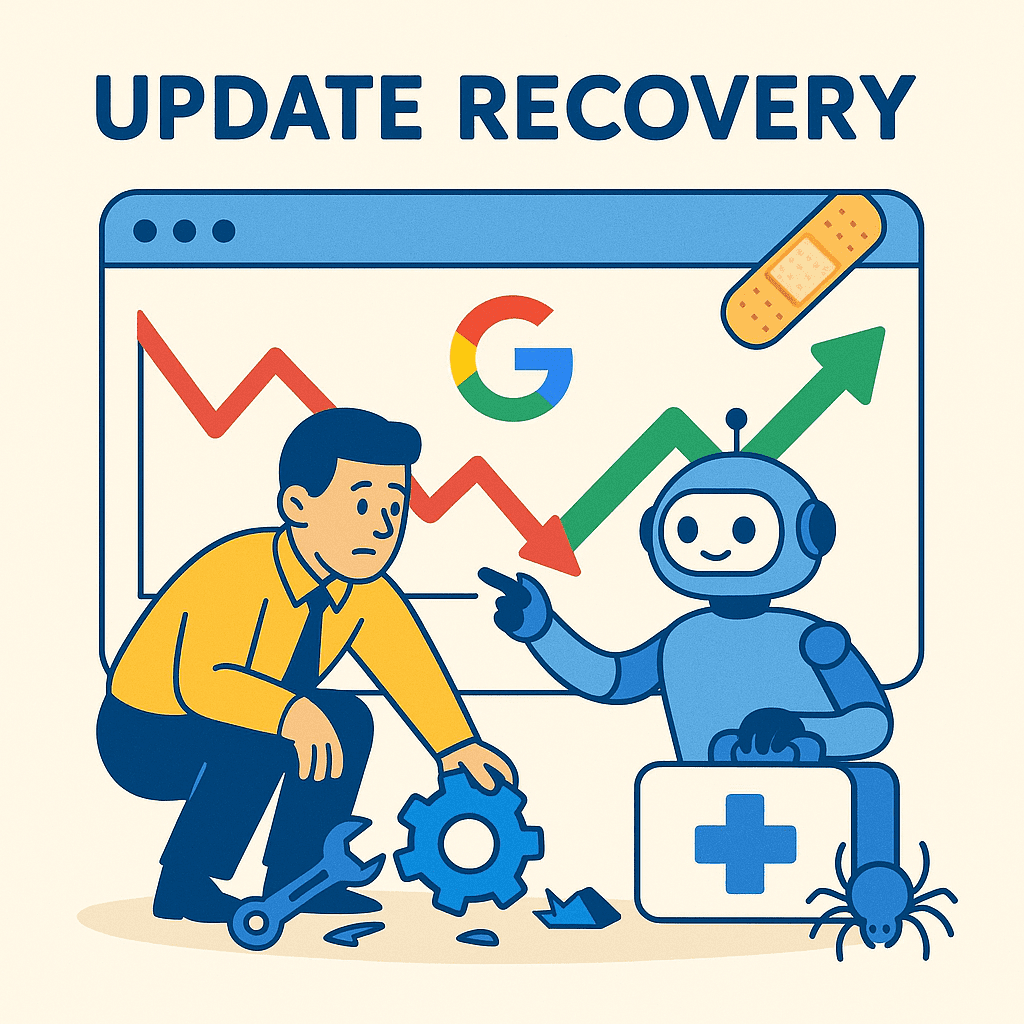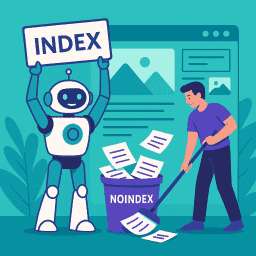Google Update Recovery: Strategies to Regain Rankings
Proven strategies to bounce back from core updates and rebuild your rankings
⚡ Lost Rankings? Here’s Your Core Update Survival Plan
So your website’s traffic just took a hit—and you suspect Google’s latest core update is to blame. You’re not alone. Every time Google rolls out a broad core update, many sites see their rankings drop without warning, explanation, or clear guidance.
The good news? Recovery is possible. The bad news? It’s rarely instant. Core updates are about re-evaluating relevance and quality, not penalising websites. That means your path back to strong performance starts with understanding what changed—and taking smart, user-focused action.
This post is your full roadmap for Google update recovery. Whether you’re a small business owner, a content creator, or a seasoned SEO, you’ll find clear steps here to audit, improve, and future-proof your site.
1. 🧠 Understand What Just Happened
Core updates aren’t penalties. They’re broad algorithm changes designed to better match search results with what users want.
- 🔄 Rankings shift because Google’s system re-evaluates page relevance and trust
- 🚫 There’s no “fix” for a penalty—because there was no penalty
- 🧮 Updates are driven by improvements in understanding intent, content quality, and user satisfaction
Start by confirming the impact. Use Google Search Console and GA4 to compare traffic and visibility before and after the update. Look for patterns in what content dropped—and what stayed strong.
2. 📊 Analyse the Damage Carefully
Don’t assume every drop is update-related. Use data to find what really changed:
- 📉 Check which pages lost impressions or clicks in Google Search Console
- 🧭 Segment traffic in GA4 by source, page, device and country
- 📄 Review bounce rate, session depth and dwell time
- 🕵️ Identify whether your content still aligns with user intent
This helps you avoid blanket changes and instead focus where recovery is most needed.
3. 🔍 Review Your Content Quality
Google has made it clear: content quality is a core ranking factor. Revisit their Helpful Content Guidelines and run an honest audit of your site.
- 📌 Is your content original and insightful?
- 🧠 Does it demonstrate expertise or first-hand experience?
- 🗓️ Is anything outdated, thin, duplicated or low-value?
- 📚 Are users finding answers quickly and clearly?
Keep what’s working. Improve what can be salvaged. Consolidate or retire what no longer serves your audience.
4. 👤 Strengthen E-E-A-T Signals
Google uses the concept of E-E-A-T—Experience, Expertise, Authoritativeness, and Trust—to evaluate content quality. If your content lacks these signals, rankings may suffer.
Here’s how to improve E-E-A-T:
- 👩💼 Add detailed author bios with real credentials
- 📚 Include citations and references to reputable sources
- 🏆 Show awards, reviews, or third-party endorsements
- 🛡️ Make your About, Contact, and Editorial pages robust and transparent
5. 🔧 Fix Technical Weaknesses
Technical SEO may not be the reason for a ranking drop—but it can definitely hold you back from recovering.
- ⚡ Improve Core Web Vitals (page speed, interaction time, visual stability)
- 📱 Ensure your mobile experience is smooth and accessible
- 🧭 Review site structure for clear navigation and internal linking
- 🧹 Clean up crawl errors, broken links, and index bloat
- 📄 Use schema markup to enhance your content’s visibility
6. ✍️ Improve Content Format & Structure
Even high-quality content can suffer if it’s hard to read or doesn’t match how people search. Structure matters.
- 📝 Use headings (H2, H3) to break up information logically
- ❓ Add FAQs and summaries to help AI and users understand fast
- 📷 Include visuals, charts, or examples to boost engagement
- 🔗 Use internal links to connect related pages and support SEO
- 👀 Front-load value in the first paragraph—get to the point quickly
7. 🔗 Boost Off-Site Signals & Visibility
Recovery isn’t just about your site. What happens off your domain still matters. If your brand has faded from the conversation, rebuild it.
- 📰 Pitch guest content or expert quotes to industry blogs
- 🎙️ Share thought leadership via podcasts, YouTube or social
- 🔁 Repurpose older posts into shareable visuals or short videos
- 💬 Encourage reviews on trusted platforms (especially for local SEO)
- 🔍 Use digital PR to earn new high-quality mentions and links
8. 🚫 Know What NOT to Do
In the scramble to recover, many site owners make mistakes that cause more harm than good:
- ❌ Don’t rewrite everything immediately—Google may re-evaluate pages over time
- ❌ Don’t mass delete content unless it’s genuinely poor or irrelevant
- ❌ Avoid keyword stuffing or over-optimising pages
- ❌ Don’t panic-publish AI-only content just to “fill the gap”
- ❌ Don’t try to manipulate rankings with cheap links or outdated tactics
9. 🧪 Monitor, Test, and Wait
Recovery takes time. Google has said improvements may not be reflected until the next core update—but that doesn’t mean you’re powerless in the meantime.
- 📈 Track performance in Search Console and analytics weekly
- 🧪 Use split testing or change tracking tools to test content updates
- ⏳ Be patient—Google’s reassessment process can take weeks or months
- 📢 Stay plugged into SEO news, forums, and expert commentary
10. 🔮 Prevent Future Hits
The best recovery is prevention. Build resilience into your site and processes.
- 🧹 Run a content audit every quarter
- 👩💻 Hire or feature subject-matter experts for sensitive topics
- 📋 Document SEO and content guidelines for your team
- 📬 Diversify traffic sources (email, referral, social media)
- 🛠️ Automate alerts for traffic and crawl anomalies
✅ Final Thoughts
A core update hit is stressful—but not final. Many sites have recovered stronger than ever by taking a calm, structured approach to fixing weaknesses and focusing on user value.
Google wants to reward helpful, expert-led content. The best way to climb back up the rankings is to earn your place again—with content people love, trust, and engage with.
Stay steady, keep improving, and remember: the algorithm isn’t your enemy—it’s your audience, at scale.
📝 Recap and Clarify: Post-Specific FAQs
What should I do first after a Google update hits my site?
Start by staying calm and checking your traffic and rankings via Google Search Console. Identify which pages or queries dropped and compare performance pre- and post-update.
How can I tell if a Google update caused my traffic drop?
Check whether the drop aligns with known update dates. If multiple sites across your niche were affected and there’s no technical issue, it’s likely algorithm-related.
What role does E-E-A-T play in recovery?
Google increasingly prioritises Experience, Expertise, Authoritativeness, and Trustworthiness. Strengthening author bios, credentials, and trust signals helps rebuild rankings after an update.
Should I delete or update underperforming content?
Start by auditing your content. Update anything still useful and relevant; delete thin, outdated, or irrelevant pages that aren’t worth saving. Focus on quality, not quantity.
Do backlinks help with recovery after an update?
Yes—but only if they’re relevant and high quality. Building strong, contextual links through digital PR or content outreach can help re-establish authority and visibility.
Can technical SEO affect update recovery?
Definitely. Crawlability, speed, mobile usability, structured data, and internal linking all influence how your site is evaluated post-update. Fix technical issues early in your recovery plan.
How long does recovery from a core update take?
Recovery timelines vary. Some improvements may show within weeks, but full recovery often takes months—especially if another update is needed to reassess your site.
Should I stop publishing new content after an update?
No. Keep publishing—but prioritise quality over quantity. New, relevant, intent-matching content can help signal to Google that your site remains active and useful.
Can Google penalties look like algorithm hits?
Yes. Manual actions can cause sharp ranking drops that mimic algorithmic impact. Check the Manual Actions section in Google Search Console to rule this out.
What’s the most important takeaway after a ranking drop?
Don’t panic or chase the algorithm. Focus on long-term quality—auditing your site, improving E-E-A-T, and delivering the best possible experience to your users.
Every algorithm change is a chance to tighten your SEO and leave competitors behind. – David Roche


















